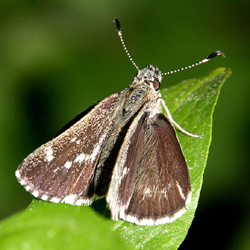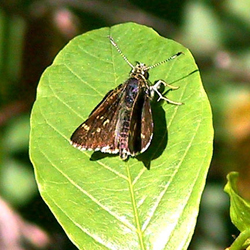Find a Butterfly
Pepper and Salt Skipper
Amblyscirtes hegon
Named
Scudder, 1864

Identification
Wingspan: 7/8 - 1". This small, dark skipper is similar to Common Roadside Skipper (A. vialis) but may be distinguished by its grayish-green underwings which are distinctly marked with a series of white to gray spots. These contrasting spots are also apparent on the dark brown upperwing surface, although often vague on the hindwing while bold on the forewing.
Distribution
Southern Manitoba east to Nova Scotia; eastern Texas east mainly through the Appalachian Region to New England; scattered reports from northern Florida, Georgia, and the mid-Atlantic states. Throughout New England excepting Maine‘s northermost region as well as Massachusetts‘ Cape Cod and Islands.
Status in Massachusetts
Atlas records indicate this species is fairly widespread, albeit uncommon, in much of the state though absent from most of the southeastern region. Note, however, Mello‘s record from North Dartmouth on the western side of Buzzard‘s Bay. Scudder (1889) reported this butterfly from only 4 locales: Amherst, Springfield, Belmont and Milford. Maximum: 7 on 29 May 1992, Worcester - BMBWS (Worcester Co.).

Flight Period in Massachusetts
One flight: late May through late June. Opler and Krizek (1984) mention that ". . . rare, late-emerging adults are occasionally found in late July. Dunbar‘s two records from western Massachusetts on August 8, 1988 (Sheffield) and August 28, 1988 (Williamstown) seem to confirm this phenomenon. Extreme dates: 19 May 1988, Framingham (Middlesex Co.), R. Forster and 28 August 1988, Williamstown (Berkshire Co.), E. Dunbar.
Larval Food Plants
Grasses, including Kentucky blue grass (Poa pratensis) and Indian Grass (Sorghastrum nutans).
Adult Food sources
Like other "roadside" skippers in the genus Amblyscirles this species seldom visits flowers although viburnum and blackberry are given by Opler (1984) and atlas workers recorded nectaring on Wild Geranium and Bluets.

Habitat
Woodland openings including glades, paths and railroad track right-of-ways. At times this species and Common Roadsike Skipper (A. vialis) may be found together.
Life Cycle
EGG and OVIPOSITION: Unrecorded. LARVA: Brown-headed with reddish eyes; light green body with green and white stripes. CHRYSALIS: Pale yellow with greenish markings. OVERWINTERING STAGE: As larva.
Groups of two or three adults may be found perched on grasses within a few yards of each other.
Account Author
Richard K. Walton



